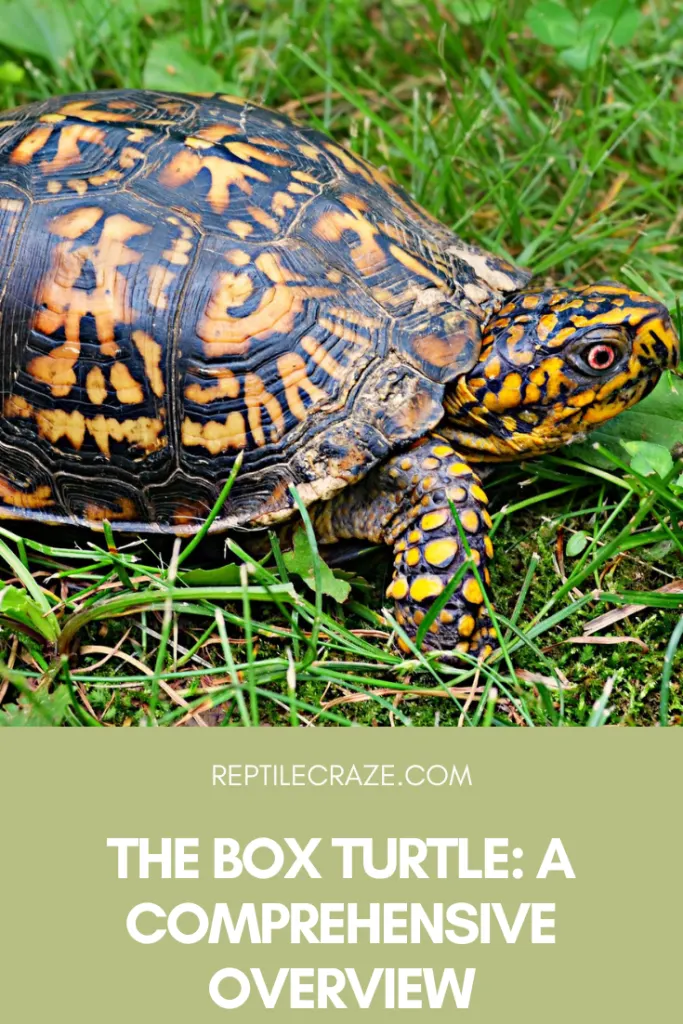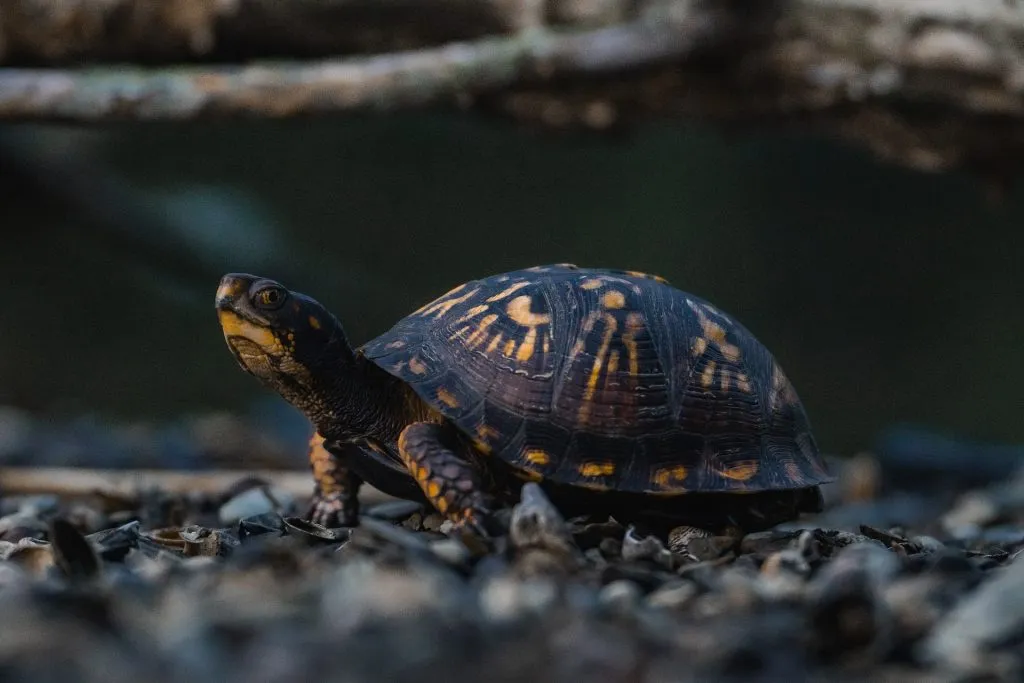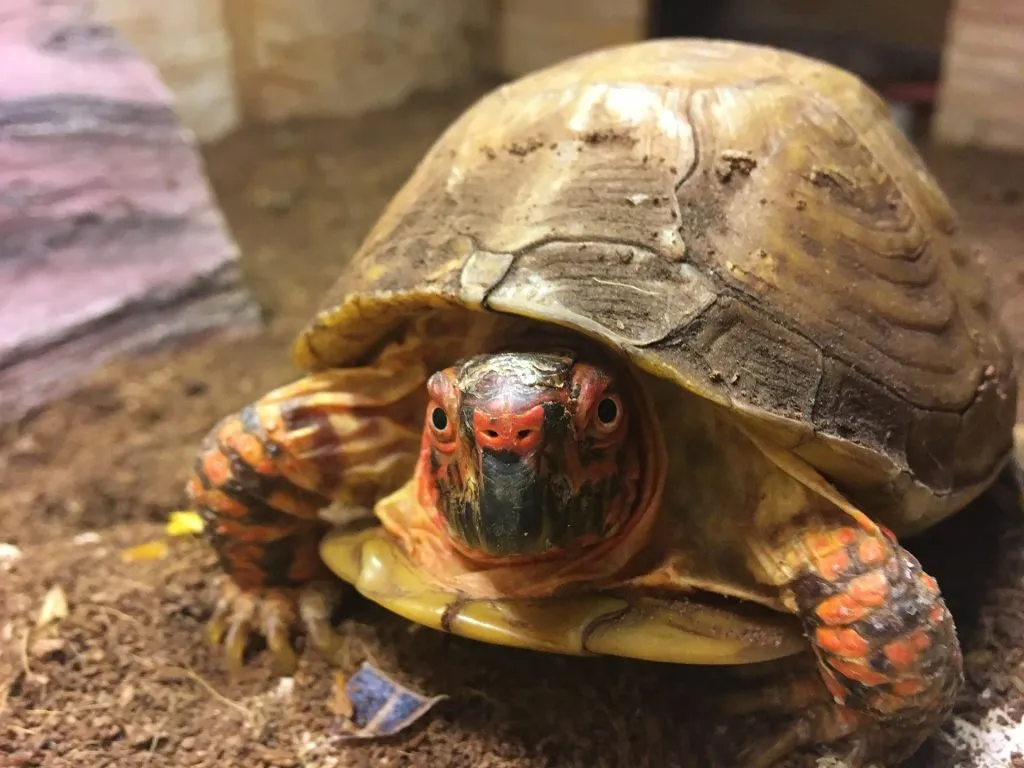Ever stumbled upon a cool, dome-shelled creature while wandering in a North American forest? Chances are, you’ve just met the Box Turtle. Spread out from the dense eastern US forests to the sunny vibes of Mexico, these turtles have a charm that’s hard to miss. Dive in, and let’s explore what makes these critters tick.

Unpacking the Box Turtle’s Scientific Classification
Science, while incredibly fascinating, can sometimes come across as a jumble of Latin words. So, when we talk about the Eastern Box Turtle’s scientific name, (Terrapene carolina carolina), let’s break it down to understand what it’s telling us.
At its core, taxonomy – the science of classification – has a way of organizing and categorizing every living creature. Each organism gets a two-part Latin name; think of it as the first and last name for humans. The first part indicates the genus (like our surnames), and the second part signifies the species (akin to our first names).
Now, here’s where the Eastern Box Turtle throws in a curveball with that extra carolina. When an organism has its species name repeated, it’s signaling that it’s a subspecies. This means it’s a specific variation of the broader species. For our turtle buddy, the first carolina gives us a heads-up that it belongs to the carolina species. The repeated carolina? That’s letting us know it’s a unique subspecies of that broader category.
So, while at first glance it might seem like an echo, that repetitive name is actually offering a goldmine of information about the turtle’s position in the grand biodiversity scheme. It’s a testament to how detailed and meticulous scientists are when it comes to understanding and cataloging the rich tapestry of life on our planet. And that, in essence, is the beauty of taxonomy!
Box Turtle Conservation Overview
Let’s get into the nitty-gritty about the box turtle’s conservation situation. While many of us know them as those slow-moving, gentle creatures we occasionally spot in woodlands, there’s more beneath the surface.
Firstly, habitat loss is a biggie. With our cities expanding and roads cutting through landscapes, the habitats of box turtles in places like the eastern United States are shrinking and fragmenting. This not only limits their space but also poses direct threats, like road fatalities.
Then there’s the pet trade angle. The allure of having a box turtle as a pet has surged in recent times. While they might seem like low-maintenance pets (and they kind of are), removing them from their wild habitats can disrupt local ecosystems and further strain their declining populations.
Moreover, for those thinking, “Oh, it’s just one turtle for my backyard pond, how harmful could it be?”—well, cumulative demand can result in thousands of box turtles being removed from their natural environments annually. This disrupts their breeding, feeding, and natural behaviors, which can have cascading effects on the ecosystems they belong to.
Now, onto the conservation status itself: While some subspecies of box turtles are listed as endangered in specific regions, others are considered ‘of least concern.’ However, given the rising challenges, conservationists and scientists are calling for closer monitoring and protective measures.
In essence, it’s essential to strike a balance. Keeping the wild turtles in the wild, preserving their habitats, and monitoring their populations are key. If you’re genuinely keen on having a turtle companion, considering adoption or sourcing them responsibly can make a world of difference. It’s about doing our part and letting these reptiles do their turtle-y thing in peace.

Box Turtle Locations: A Closer Look
Let’s take a moment to really dive into where the box turtles call home. These reptiles have an impressive range, and they’ve made some interesting choices in locales. If you thought you were picky about where you live, wait until you hear about these turtles!
Starting off in the eastern United States, box turtles, especially the Eastern Box Turtle (Terrapene carolina carolina), can be commonly found from the forests of New England to the more temperate regions of Georgia and even further south. Within these areas, they prefer deciduous forests where they have ample access to their favorite foods, and leaves they can use for cover. Plus, these environments provide perfect spots for them to hibernate during colder months.
Now, journeying further south, the box turtle doesn’t limit itself to just the U.S. Mexico, particularly around the Yucatan Peninsula, is also a favored hangout. Here, the conditions differ from their northern habitats. With more sandy trails and even some semi-arid regions, box turtles have adapted to these settings as well. They might spend more time near water sources and are often seen navigating through the scrubby terrains.
While they’re fairly versatile in terms of their habitats, it’s fascinating to think about how they’ve evolved and adapted over time. Whether it’s the dense, leaf-littered woods of the U.S. or the sun-drenched trails in Mexico, box turtles have carved out a niche for themselves, demonstrating nature’s wonderful ability to adapt and thrive in diverse conditions.
Digging Deeper into Box Turtle Facts
- Size, Appearance, & Behavior: Box turtles, with a typical size ranging from 4 to 7 inches in length, might seem modest at first glance. But if you spend a bit of time watching them, their unique details pop. The carapace, or the upper shell, showcases a range of patterns and colors – a medley of brown shades blended with deeper, more vibrant hues. Now, let’s talk about their underbelly. Their plastron, which is the technical term for the lower shell, is hinged. This nifty adaptation lets them tuck themselves in almost entirely, mimicking a sealed box. Beyond being a cool party trick, this design provides them with a powerful defense mechanism against potential threats. This evolution-backed feature ensures they’ve got a survival edge in the wilderness.
- Habitat: While many box turtles are content in forested areas and meadows, some like to shake things up. Take the Gulf Coast Box Turtle, known scientifically as Terrapene nelsoni. Unlike its woodland-loving cousins, this particular turtle has a penchant for marshy, water-logged environments. It’s an adaptation that showcases the incredible diversity within the box turtle genus, reminding us that even closely related species can have varying habitat preferences based on their evolution.
- Predators and Threats: Having a hard shell is undoubtedly an advantage in the animal kingdom, but it’s not an all-access pass to a threat-free life. Young box turtles, or hatchlings, have softer shells, making them a choice meal for birds and other predators. As they grow, their list of natural predators diminishes, but it doesn’t disappear. Raccoons, skunks, and even some larger birds won’t say no to a turtle snack. And then there’s the human factor – habitat destruction for infrastructure, roads, and the unfortunate pet trade has made life increasingly challenging for these reptiles.
- Diet: Box turtles don’t subscribe to dietary fads. They’re opportunistic omnivores, meaning they’ll munch on whatever’s available. On a good day, that could mean feasting on ripe berries, but when the pickings are slim, they’re just as happy to hunt down insects, worms, and yes, even the occasional slug. Their dietary flexibility is a testament to their adaptability and resilience in changing environments.
Reproduction and Life Cycle of the Box Turtle
When springtime hits, usually around April, box turtles get into the romance groove. If you’re ever wandering the woods during this period, you might just come across an intriguing courtship display. Males, easily distinguishable by their bright, often red or orange eyes, engage in a gentle dance to woo their potential partners. It’s not the cha-cha or tango, but in the turtle world, it’s every bit as impressive.
After these little courtship rituals, successful mating couples will get down to the business of ensuring the next generation. The females, the unsung heroes in this tale, embark on a challenging journey. They search for the perfect nesting spot, often a soft, sandy patch where they can safely bury their eggs. A typical clutch can consist of several eggs, and if all goes well, around July, the world welcomes new box turtle hatchlings.
These hatchlings have a lot to contend with, right from predators to environmental challenges. However, those who make it through their vulnerable early years can enjoy a life that spans several decades. Some box turtles have even been known to live for over a century!
Box turtles have a pretty fascinating life journey. They face various challenges and experiences, but it’s all part of what makes their story so special. From those little mating dances to the day their babies hatch, every moment is a testament to nature’s wonders.

Q&A
Q: What are the defining features of the limbs of a box turtle?
A: Box turtles have sturdy limbs adapted for terrestrial life. Their limbs are strong and clawed, aiding in digging and navigating through their habitats.
Q: Are the shells of box turtles typically brown?
A: Yes, many box turtles sport brown shells, though the shade can vary, and they often have yellow or orange patterns or spots to add some flair.
Q: What is the significance of mushrooms in the diet of box turtles?
A: Mushrooms form a part of the varied diet of box turtles. Being opportunistic omnivores, they consume mushrooms along with other vegetation, small amphibians, and insects.
Q: How do box turtles create nests?
A: Female box turtles dig shallow nests in soft or sandy soil using their hind limbs. These nests protect their eggs during the incubation period.
Q: Are box turtles native to North America?
A: Absolutely! Box turtles are primarily native to North America, with various species and subspecies scattered throughout the region.
Q: Can a single mating produce multiple batches of fertile eggs in box turtles?
A: Yes, after a successful mating, females can store sperm and lay multiple batches of fertile eggs over a period without needing to mate again.
Q: What are some fun facts about the common box turtle?
A: One fun fact is that the common box turtle can completely retract its head and limbs inside its shell. Also, despite their terrestrial nature, they can swim and may occasionally soak in water.
Q: Are box turtles often kept as popular pets?
A: Yes, box turtles, due to their unique appearance and manageable size, have become popular pets. However, it’s essential to ensure their needs are met and to source them responsibly.
Q: At what age do box turtles reach sexual maturity?
A: Box turtles generally reach sexual maturity between 5 to 10 years, though it can vary based on the specific species and environmental conditions.
Q: What’s unique about the Coahuilan box turtle?
A: The Coahuilan box turtle, or Terrapene coahuila, stands out as the only known aquatic box turtle. Native to a small area in Mexico, it’s adapted to a more aquatic lifestyle than its relatives.

Q: Why are box turtles commonly referred to with that name?
A: The “box” in their common name refers to their unique hinged plastron (the lower part of the shell), allowing them to completely close up, resembling a box.
Q: Are box turtles found in the state of Florida?
A: Yes, Florida is home to various species of box turtles, including the Eastern and Gulf Coast varieties.
Q: What are the typical habits of the Mexican box turtle from the state of Yucatan?
A: The Yucatan box turtle, like other box turtles, is terrestrial, prefers woodland habitats, and has a diet comprising both plants and small animals.
Q: Which box turtle species is known to be aquatic?
A: The Coahuilan box turtle, Terrapene coahuila, is unique as the only known primarily aquatic box turtle.
Q: Is the ornate box turtle different from American box turtles?
A: Yes, the ornate box turtle is a specific subspecies of the North American box turtles. It’s characterized by its distinct shell patterns and is mostly found in the Midwest.
Q: Do box turtles consume small amphibians?
A: Absolutely! Box turtles, being omnivores, can consume small amphibians as part of their varied diet.
- Enchi Ball Python: A Unique and Stunning Morph of Python regius - March 27, 2025
- Emerald Tree Monitor: The Enigmatic Green Guardian of the Rainforest - March 26, 2025
- The Egyptian Cobra (Naja haje): A Fascinating Serpent - March 25, 2025
